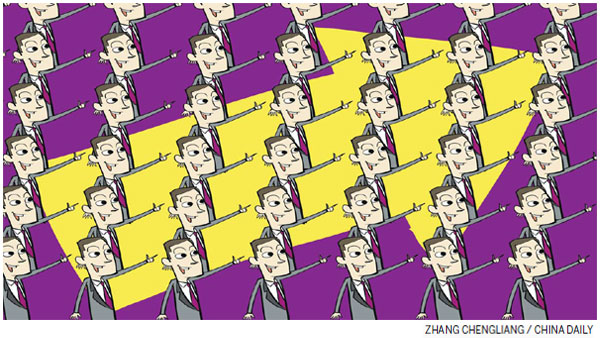On the backs of its consumers
Updated: 2015-02-13 08:53
By Chi Fulin(China Daily Europe)
|
|||||||||||
Greater efforts to change the way China invests are vital to stimulate growth in its service sectors
During the next 10 years, China's economic growth will depend largely on whether the huge consumer potential of its 1.3 billion citizens is fully utilized, and whether it can transform its development model from one being driven by investment and export to one driven by consumption. So the fundamental question is whether China is entering a new era of a consumer society.
I believe the answer is yes, if the necessary free-market reforms are implemented. First, the demand for necessities (food, clothing and shelter) is falling and the demand for goods and services for human development (education, healthcare, communications, etc) is growing. The mainstay of urban residents' consumption is changing from industrial products to services, and they will be in the majority by 2020. Meanwhile, rural residents' consumption is changing from daily necessities to industrial products.

Second, material consumption is falling while service consumption is increasing. For instance, the proportion of urban residents' national average expenditure per capita on medical and healthcare, transport and communications, and on culture, education and entertainment, climbed from 12.8 percent in 1985 to 33.3 percent in 2012.
Third, the shortage of private goods has been greatly eased, while the shortage of public goods and services is becoming more and more noticeable. For instance, social security was at the top of the list of the biggest concerns of Chinese people for five consecutive years, from 2010 to 2014.
Consumer demand has been growing. First, the average level of consumption per capita has increased exponentially. In the 35 years between 1978 and 2013, the national average consumption per capita multiplied almost 85 times - from 184 yuan ($29.4, 25.9 euros) in 1978 to 15,632 yuan in 2013. Second, the untapped potential of the consumption of services, such as medical and healthcare, is massive. For example, the annual demand of special products for the elderly is estimated at 1 trillion yuan, but the current annual supply has only been 100 billion yuan, which leaves a huge gap to be filled.
Total consumption has been expanding. First, added consumer demand has been growing. In 2012, newly added urban and rural residents' consumption demand exceeded 2 trillion yuan, almost as large as annual total consumption in the 1990s. Second, the total size of consumption has been gradually increasing. The expenditure of urban and rural residents' final consumption rose from 175.91 billion yuan in 1978 to 19.04 trillion yuan in 2012, and to about 24 trillion yuan in 2013. It is estimated that the total size of consumption in Chinese mainland will reach 45 trillion to 50 trillion yuan in 2020.

The huge consumer demand of 1.3 billion people is China's biggest advantage. Expanding domestic demand and boosting consumption will greatly affect its economic growth and will drive the economy at an annual growth rate of around 7 percent over the next 10 years. In 2020, China's final consumption rate is expected to reach 60 percent, with residents' consumption rate around 50 percent. Driven by such huge consumer demand, it is possible for China to maintain economic growth of around 7 percent.
This will advance the structural re-adjustment of the economy. Changes in the consumption structure are bound to bring profound changes to industry. As is estimated, the service sector's contribution to GDP in China will climb from 46 percent to 49 percent in the next two years. And it is likely that service sectors will take up 55 percent of total GDP by 2020.
In the next seven years, if the economy grows at around 7 percent (as anticipated), GDP per capita will rise to around $12,000 by 2020. Thus, China will have successfully become a high-income economy.
China's consumer-driven economy will have some vastly different characteristics in 2025 from its economies of the past few decades. The major change will be the rapid development of service sectors in the new era of consumption. Next year, China's tertiary industry will account for more than half of its total GDP, initially establishing the dominant role of service sectors in driving economic transformation and development. Yet the key to developing tertiary industry is to open up the market and to promote institutional innovations.
Evidence has shown that China's service supply cannot meet the demand of its society, and that the investment gap in service sectors is not because of capital shortage, but because of the delay in opening up the economy. To vigorously promote the development of the tertiary industry the key lies in breaking up administrative and monopolistic control, and in giving full play to the role of private capital.
Another major trend is migration from rural to urban areas. In 2013, China's physical urbanization rate was 53 percent, while the population urbanization rate was only 35 percent. Not long ago, the Chinese central government made a resolution to reform the hukou (household registration) system, allowing rural residents to register their residences in medium and small-sized cities and townships, while rationally restricting the population size in major cities such as Beijing and Shanghai.
Therefore, the process of integrating rural migrants into urban areas (in terms of granting rural migrants urban hukou and equal access to public services now enjoyed only by urban residents) is sure to speed up in the next three to five years, and the population urbanization rate is likely to surpass 53 percent by 2020.
Upgrading the consumption structure and expanding the total size of consumer demand will determine the orientation of structural changes in investment growth. A core goal of consumption-driven economic transformation is to effectively expand investment by increasing demand for services. In 2010 and 2011 investment in the manufacturing sectors and real estate industry took up 54.7 percent and 59.1 percent of total investment, respectively, leading to a serious shortage of investment in the service sectors.
China needs to make greater efforts to promote structural reform of investment. This will help realize a dynamic balance between investment and consumption so as to stimulate investment in the service sectors.
The author is president of the China Institute for Reform and Development in Hainan province. The views do not necessarily reflect those of China Daily.
(China Daily European Weekly 02/13/2015 page10)
Today's Top News
Ceasefire agreed for E.Ukraine
Russia's YotaPhone places big bet on China
EU leaders to urge stricter border checks in counter-terror drive
Leaders hold Ukraine peace talks as fighting surges
Costa Concordia captain sentenced to 16 years for 2012 shipwreck
Chinese investors shifting focus in global realty purchases
Greek PM easily wins confidence vote
Contact group on Ukraine reaches ceasefire deal
Hot Topics
Lunar probe , China growth forecasts, Emission rules get tougher, China seen through 'colored lens', International board,
Editor's Picks

|

|

|

|

|

|





